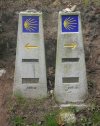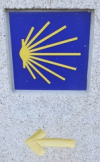Excursionista
happiest when walking
- Time of past OR future Camino
- De VdBierzo (2004)
Pamplona-Sahagún (2021)
So... after several forum searches, I think I've figured it out but would appreciate confirmation.
When I started walking from Pamplona in November, I was very confused because the shells and arrows sometimes seemed to be pointing in opposite directions. Apparently, I had deeply internalized the Galician system when I walked from Villafranca del Bierzo in 2004, and my impulse to follow the rays of a Camino shell was as deeply embedded as following the pointy end of an arrow.
As I walked from Pamplona to Sahagún, I saw many shells pointing the "wrong" way and many that seemed to only be decorative markings accompanying arrows, without any direction of their own. I certainly understand the logic of the "all roads lead to Santiago" interpretation, but it turns out to be very difficult to assign a new meaning to a familiar symbol! I never did fully adjust, but I learned to look for arrows instead.
From others' experience, is it true that only Galician arrows use the direction of the rays to indicate the direction of the Camino?
When I started walking from Pamplona in November, I was very confused because the shells and arrows sometimes seemed to be pointing in opposite directions. Apparently, I had deeply internalized the Galician system when I walked from Villafranca del Bierzo in 2004, and my impulse to follow the rays of a Camino shell was as deeply embedded as following the pointy end of an arrow.
As I walked from Pamplona to Sahagún, I saw many shells pointing the "wrong" way and many that seemed to only be decorative markings accompanying arrows, without any direction of their own. I certainly understand the logic of the "all roads lead to Santiago" interpretation, but it turns out to be very difficult to assign a new meaning to a familiar symbol! I never did fully adjust, but I learned to look for arrows instead.
From others' experience, is it true that only Galician arrows use the direction of the rays to indicate the direction of the Camino?




















